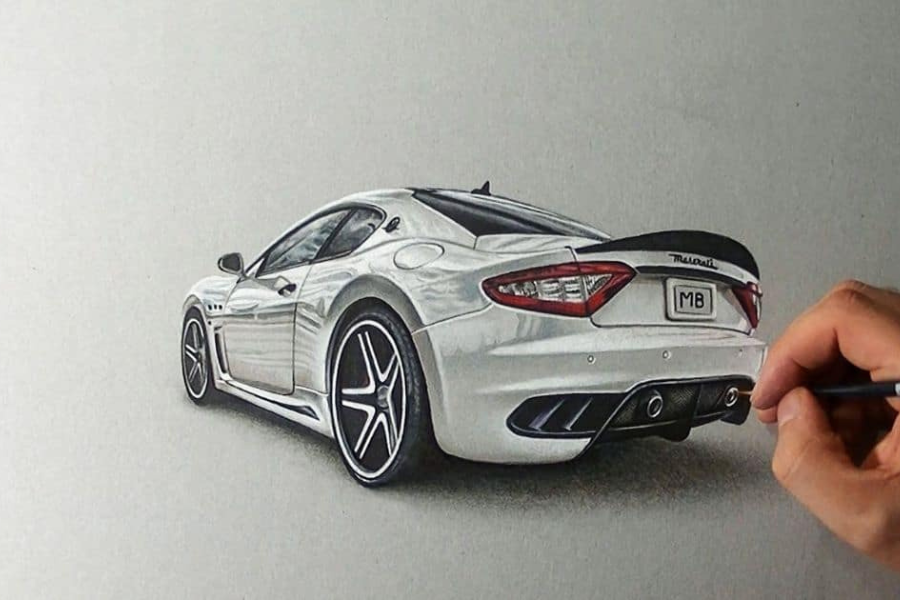Introduction
Drawing automobiles offers a fascinating artistic journey, where the complexity of car designs meets the creativity of the artist’s hand. Cars, with their sleek forms and technical details, serve as compelling subjects that enhance observational skills through practice and patience.
Understanding Drawing: A Creative Journey
Becoming the best at drawing vehicles includes an excursion of disclosure. By zeroing in on design, lighting, and surface surfaces, specialists grow their capacity to notice and decipher their subjects. Drawing turns out to be in excess of a specialized expertise; it develops into a method for creative articulation, permitting craftsmen to foster their remarkable style while catching the substance of auto plan.
Why Drawing Cars Captivates Us
The allure of attracting vehicles lies their smooth bends, refined forms, and the combination of workmanship with designing. Vehicles hold social importance, taking advantage of our appreciation for plan and innovative wonders. Delivering these versatile machines draws in watchers with subjects that represent speed, extravagance, and advancement.
Why Learning to Draw Cars is Important
Learning the basics of drawing vehicles fills in as a phenomenal starting point for any hopeful craftsman or architect. Auto subjects offer visual intricacy that creates fundamental abilities like overshadowing, extent, and three-layered structure. Drawing vehicles improves specialized skills as well as develops an eye for stylish subtleties and the capacity to interpret virtual plans onto paper.
Avoiding Common Drawing Errors
The key to sketching cars well is to follow a methodical process. To properly represent dimensions, start by examining reference materials from a variety of perspectives. Before adding minute details, make sure all forms and positions are accurate by lightly drawing construction lines. For expressing the dynamic character of automobiles and minimizing perspective errors, gesture drawings are important.
Finding errors in the dimensions, angles, or feature spacing of drawings can be facilitated by routinely comparing them to references. Realistic shading and depth in automobile surfaces depend on an understanding of how light interacts with them. Realistic proportions and construction strokes are maintained while establishing linear perspective.
Striving for Betterment: Soliciting Feedback and Enhancing Skills
To get better at sketching cars, one must proactively seek out criticism from peers, mentors, and online forums. A measure of advancement and places in need of improvement can be obtained by contrasting newer and older works. Participating in discussion boards and social media platforms provide a safe space where people may share their work-in-progress, get feedback, and learn from one another.
The goal of feedback sessions should be to focus on constructive criticism that leads to real progress. Looking back at previous sketches might help you find patterns and places that need work. Examining the works of great artists inspires and improves one’s own creative process in a variety of media and forms.
Essential Tools and Materials for Car Drawing
A well-stocked toolbox is necessary for efficient car sketching. Full range of values may be achieved with pencils ranging from soft to hard, and a kneaded eraser softly lifts graphite for accurate changes. The realism of car drawings may be increased by overlaying tones and textures on textured paper.
Drawings are kept in sketchbooks for future reference and growth, and a Sharpie marker makes it easier to clearly finish bold lines. Accurately capturing textures and adding authenticity to artwork is made possible by observing and gathering genuine automobile surfaces.
Transforming Your Sketch into Digital Art
Advancements in technology allow hand-drawn car sketches to be digitized and enhanced using software like Photoshop. Digital tools enable artists to add metallic, candy, or pearlcoat finishes that were previously impossible with traditional media. They can refine edges, integrate backgrounds, and experiment with compositions, expanding the possibilities for automotive digital art.
Sharing Your Creations
Sharing car drawings online or in exhibitions showcases artistic progress and invites feedback and discussion. It fosters a sense of community and encourages ongoing improvement. Exhibiting artwork publicly not only promotes personal growth but also enriches the broader appreciation of automotive art.
Grasping Car Anatomy
A thorough understanding of automotive design elements enhances the realism of car drawings. Studying frames, suspensions, powertrain components, and interior layouts familiarizes artists with integrated systems and styling cues. Analyzing factory diagrams and assemblies deepens three-dimensional perception, crucial for accurately rendering complex mechanical details.
Advantages of Sketching Automobiles
Sketching cars presents challenges that refine observational skills, such as estimating sizes and capturing subtle textures. It encourages experimentation with shading techniques and fosters versatility in drawing styles. Mastering automotive subjects cultivates well-rounded artistic abilities applicable to various artistic endeavors.
Improving Powers of Observation
Drawing cars demands keen attention to detail, honing observational skills in line flow, surface variations, and light interactions. Artists learn to distinguish essential features from superfluous details, enhancing visual memory and analytical drawing capabilities. Patience and concentration developed through drawing translate into valuable life skills.
Fostering Creativity and Innovation
Exploring new techniques and media encourages artistic growth and personal style development. Artists experiment with unconventional approaches, altering perspectives, and reinventing classic techniques. Curiosity drives fluency in traditional methods and opens doors to novel artistic expressions that inspire others.
Sketching Techniques for Beginners
Beginners in car drawing start with loose sketches, gradually refining details and values. They focus on building foundational shapes and observing basic volumes to develop realism. Emphasis on technique over intricate details ensures steady progress and confidence in tackling complex compositions.
Motivating Others with Your Art
Sharing car drawings inspires others and promotes artistic dialogue. Displaying sketchbooks and discussing techniques imparts knowledge and demonstrates achievable goals through dedication and practice. Teaching workshops or classes nurtures artistic communities and spreads enthusiasm for automotive art.
Embarking on the Journey of Drawing Cars
Mastering car drawing is a rewarding process that requires dedication and practice. With step-by-step guidance and consistent effort, any aspiring artist can develop realistic rendering skills. This comprehensive guide provides essential principles and techniques for starting strong on this artistic journey.
Prepare Your Drawing Tools
Investing in quality drawing supplies is crucial for success. A balanced toolkit includes pencils of varying hardness, kneaded erasers, blending tools, and textured paper. As skills advance, additional media and techniques can be incorporated to achieve more intricate details and textures.
Select a Reference Image
Choosing high-quality reference images aids in learning and mastering car drawing. Start with simpler images to grasp basic forms and progress to more complex angles and features. Live sketching offers valuable challenges and enhances observational skills.
Sketch Basic Shapes
Begin with basic three-dimensional shapes to outline the body, windows, and wheels in simplified blocks. Focus on accurate relationships between elements before refining individual details. This foundational approach establishes a strong structure for realistic car renderings.
Navigating through Challenges in Car Drawing
Every artist encounters challenges that contribute to skill development. Evaluating difficulties provides insights into strengths and weaknesses, aided by tutorials, references, and perseverance. Reflecting on challenges transforms setbacks into opportunities for growth and expertise.
Enhancing Detail and Realism
Observing subtle details such as panel gaps and surface textures enriches the depth and authenticity of car drawings. Layering tones smoothly emphasizes curves and dimensions, while refining small features maintains overall balance and accuracy. Comparative analysis ensures fidelity to reference images.
Refining the Lines for Precision
Returning to initial constructions with a fresh perspective allows for sharper forms and cleaner lines. Focusing on accurate relationships between refined elements ensures cohesion and clarity in the final composition. Erasing unnecessary marks eliminates distractions and enhances overall visual impact.
Adding Texture and Shadows
Depicting surface textures through techniques like stippling or cross-hatching enhances realism and tactile qualities in car drawings. Understanding light sources and casting shadows adds depth and dimensionality, while gradual tonal blending ensures smooth transitions and realistic effects. Well-placed accents highlight unique features and characteristics of the subject.
Focusing on the Details
Attention to specific features that define a car model adds personality and authenticity to drawings. Balancing detailed elements with broader compositions ensures harmony and visual appeal. Selective magnification of significant details avoids overwhelming the overall composition, maintaining coherence and impact.
Finalizing Your Drawing
The final stages of drawing a car transform a good sketch into a polished artwork. Attention shifts to refining proportions, accuracy, and value usage with a critical eye. Making subtle adjustments enhances realism without overworking the composition. Focused refinement of edges and details completes the rendering process.
Sign Your Work
Adding a signature to completed drawings not only personalizes the artwork but also establishes ownership and artistic integrity. Signatures can be simple or decorative, enhancing the visual appeal while considering overall composition and balance. Signing completed works signifies achievement and pride in artistic accomplishments.
Share Your Artwork
Sharing completed car drawings celebrates artistic achievements and encourages ongoing progress. Exhibiting artwork in galleries or online platforms fosters community engagement and inspires others with passion for automotive art. Social media amplifies exposure and connects artists with global audiences, potentially leading to opportunities for growth and recognition.
Conclusion
Gaining proficiency in automotive sketching is a rewarding endeavor that blends artistic expression with technical proficiency. Automotive sketching techniques are transferable to more general qualities like tenacity, patience, and attention.Continuous learning, practice, and feedback contribute to artistic growth and community engagement. Sharing artwork freely and cultivating personal style and discoveries are essential aspects of this journey. Aspiring artists are encouraged to embrace the challenges and joys of automotive art, knowing that each sketch brings them closer to expressing their passion and creativity.
In summary, drawing cars is not just about capturing their physical form but also about conveying their essence and significance through art. With dedication and enthusiasm, every artist can embark on this enriching journey, transforming simple sketches into vibrant, lifelike representations of automotive beauty and innovation.
FAQs
1. Why should I learn to draw cars?
Learning to draw cars not only enhances your artistic skills but also improves your understanding of form, proportion, and technical detail. It’s a rewarding journey that combines creativity with precision, allowing you to capture the essence of automotive design.
2. What are the essential tools for drawing cars?
Key tools include pencils of varying hardness for shading and outlining, kneaded erasers for corrections, blending tools for smooth transitions, and textured paper for added realism. These tools enable artists to achieve detailed and lifelike car drawings.
3. How can drawing cars improve my artistic abilities?
Drawing cars challenges artists to refine their observational skills, understand light and shadow dynamics, and master techniques like perspective and texture. These skills are transferable to other artistic endeavors and contribute to overall artistic growth.
4. Can beginners learn to draw cars effectively?
Yes, beginners can start by mastering basic shapes and proportions before progressing to more complex details. Starting with simple sketches and gradually refining techniques builds confidence and foundational skills necessary for realistic car renderings.
5. What role does digital art play in car drawing?
Digital tools like Photoshop allow artists to enhance hand-drawn sketches, experiment with different finishes, and refine compositions. This digital transformation expands artistic possibilities beyond traditional media, offering new avenues for creativity in automotive art.
6. How can I receive feedback on my car drawings?
Seeking feedback from peers, mentors, or online communities helps artists identify areas for improvement and refine their skills. Platforms like social media and art forums provide valuable critique and encouragement, fostering continuous improvement.
7. What are some common challenges in drawing cars?
Challenges include accurately capturing complex shapes, maintaining proportions, and depicting realistic textures and reflections. Overcoming these challenges through practice and study improves technical proficiency and artistic expression.
8. How can drawing cars contribute to personal growth?
Drawing cars promotes patience, attention to detail, and perseverance—qualities essential for both artistic development and personal success. It also fosters creativity and innovation, encouraging artists to explore new techniques and styles.
9. Why is sharing car drawings important?
Sharing your car drawings allows you to showcase your progress, receive validation, and inspire others interested in automotive art. It builds community engagement and fosters a supportive environment for artistic dialogue and growth.
10. How do I start my journey of drawing cars?
Begin by gathering quality drawing supplies, selecting reference images, and practicing foundational techniques. Embrace challenges, seek feedback, and enjoy the process of transforming simple sketches into dynamic representations of automotive beauty.



